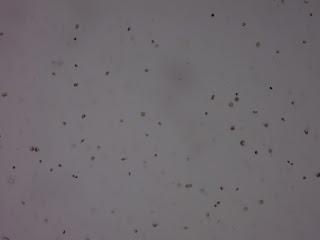Our Chaetoceros cultures have reached maturity in one week. Just looking at the bottles, I can tell right away that the culture with the most contaminate, 2500 ppm or 10 drops of oil to be exact, did anything but die. The color is slightly darker than the 250 and 750 ppm cultures, indicting that instead of complete annihilation, the oil has caused an abundance of growth.
Very carefully, we took samples of each of the contaminated bottles and placed one drop on individual slides. We captured pictures of the tiny cells, now darker in appearance because of their oil-heavy meals, and I used these pictures to calculate cell density. (For this, we calculated the area in a single field of view or FOV on a microscope at 10X, and then found out how many FOVs would be in one slide cover and multiplied the amount of cells in the FOV we captured in our picture by the ratio of a FOV to the slide cover.)
Below are pictures of the 2500 ppm culture at 10X and 40X respectively.
From the data, I was able to compute that the cell density of the 2500 ppm culture was on average 2,510,000 cells/mL. Compare this to the control cultures, which averaged a cell density of 860,000 cells/mL. That's nearly a 1:3 ratio (actually 1:2.97, but close enough).
The 250 and 750 ppm cultures came out to 1.24x10^6 and 1.31x10^6 cells/mL.
This data disproves my hypothesis of the 2500 ppm of oil killing all the plankton, but it does illustrate something amazing. A concentration of 2500 ppm of crude oil is an impossibility in a real spill. With the constant current of the ocean dispersing the oil over its surface and the lack of any boundaries (besides the shore) containing the oil to one section of the sea, the oil would never be able to remain all in one area long enough to reach a concentration that high. So the fact that the diatoms were able to not only survive but thrive under these unrealistically strenuous conditions shows that these organisms are perfectly capable of coping with spill conditions without the need of any clean up whatsoever. (Whoa.)
Moving on, after we recorded all the necessary data, we had to discontinue our experiment cultures. The reasoning behind this is that with every day these cultures are allowed to grow, the chance of an uncontrollable contaminate such as a bacteria or virus polluting and overtaking the cultures becomes more probable. This would lead to confounding evidence as we wouldn't be able to determine whether cell death would be due to the oil or another contaminate.
For the next round of experiments, Mr. Soderblom and I decided to move away from diatoms to a green or brown phytoplankton. This is because, while diatoms are the most populous group of plankton in the Louisiana Bay area, they are not the select food source for zooplankton. Diatoms, unlike other species, have a sodium metasilicate shell covering their cell walls. This makes them harder to digest and somewhat toxic to zooplankton when consumed in large quantities. Green and brown phytoplankton, however, are eaten by almost every species of zooplankton and even constitute the diet of other creatures of the ocean, such as fish, sponges, sea stars, and even whales.
So the two species we have decided to culture for the next round of experimentation are Chlorella vulgaris and Tetraselmis suecica (I'm not exactly sure on the Tetraselmis species, but I'm pretty sure it's that one). Both are between 10 and 12 micrometers in width, making them easy to observe, and the Tetraselmis is motile, making it fun to watch. Below are pictures of the Chlorella and Tetraselmis respectively at 10X and 40X.
We plan on exposing these buggers to oil starting this Friday.
Signing off till next time, this is Erin Butcher.




"So the fact that the diatoms were able to not only survive but thrive under these unrealistically strenuous conditions shows that these organisms are perfectly capable of coping with spill conditions without the need of any clean up whatsoever. (Whoa.)" I agree. A "whoa" seems in order. Did Soderblom have any comment on that?
ReplyDeleteHe was as amazed as I. He originally predicted my hypothesis would hold true because nothing can usually survive when exposed to that high of a concentration of crude petroleum. I believe (after some more in depth research) that the cause for this growth is the abundance of organic compounds like nitrogen and sulfur that exist in the oil in its crude state, but it may also be because of the hydrocarbons that constitute the petroleum part of the oil.
DeleteFascinating! I'll be very curious to see what happens to your next batch of cultures. Will you try feeding them to zooplankton?
ReplyDeleteThat's what we have in mind. We may test the green algae multiple times before doing this, just to ensure continuity in results. If we end up lacking time, then we'll just stick to the phytolankton.
DeleteThat is so exciting! I can't wait to see how the phytoplankton do. You may have already addressed this earlier and I just forgot, but is the density of diatoms in the ocean similar to that of your groups at the beginning of experimentation?
ReplyDeleteI haven't addressed it, so you bring up a valid point. No, I believe our cultures are much more concentrated, even in the very beginning. This helps us to see a much more exaggerated difference in the affect of the oil, whether it be good or bad.
Delete